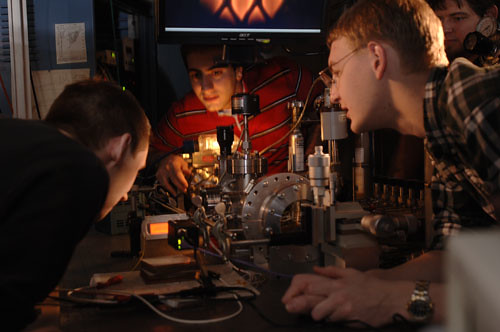Building Campaign Navigation

Recent Posts
- ECE ILLINOIS dedicates two sculptures at new building
- ECE Building includes state-of-the-art music lab
- Donor wall celebrates leadership donors to the Building Campaign for ECE ILLINOIS
- Robotics Laboratory prepares students for the future
- A revamped Digital Signals Lab
- ECE Building grounds’ history with Illinois
- Generating improved power labs
- Low donation funds classroom wing
- Introducing the Open Projects Lab
- $1 million gift makes Srivastava Senior Design Lab possible
THE BUILDING CAMPAIGN FOR ECE ILLINOIS
LOPE moving to new ECE building
In 1950, ECE faculty established the Gaseous Electronics Laboratory, now known as the Laboratory for Optical Physics and Engineering (LOPE). The laboratory is committed to the pursuit of new and efficient sources of visible, ultraviolet, and vacuum ultraviolet radiation. Since 1962, LOPE has been located in its own building near the corner of Wright and Healey streets in Champaign. The building was not intended to last this long. On the laboratory’s current location, ECE Professor Gary Eden said, “It’s a building that, because of its age, is not well-suited for doing experiments with the very sophisticated optical equipment that we have.” The current building has several drawbacks. “The heating ventilation and air condition system was not designed to control humidity, for example, or even temperature.” In order to ensure a tightly controlled environment, then, Eden had to be creative. “If you go to the laboratory today, you’ll find that there are cleanrooms that I have had to have constructed in California, shipped here and assembled inside the building. So I have a building within a building.” In order to provide LOPE with the resources and environment it needs, the laboratory will join ECE in the new building when it opens next fall.
LOPE’s space in the new ECE building will be much higher quality. “It will be nice to be located in a facility where the humidity and the temperature are better controlled, and the filtration is such that you’re not getting fine particles ejected into the room,” said Eden. While he and his colleagues are sentimental about their current building due to the laboratory’s long history there, the benefits to moving are numerous. The placement of the laboratory in the building was well planned by the building designers and Professor Phil Krein, the chair of the new building committee. “We’re slated to occupy the lowest level in the new building. It’s closer to the foundation, and of course we do optical experiments and they benefit from or require stability, that you get as little vibration from passing traffic as possible.” This is one of the ways that the new building will be a significant improvement over LOPE’s current location. Eden explained, “What really is important is when you have a facility that permits you to do something you couldn’t do before, or it allows you to do something much more efficiently or quickly. And both of those are true.”
Another significant benefit will be LOPE’s new proximity to many buildings and departments that LOPE professors and researchers interact with. Especially advantageous is being in the same building as ECE. When speaking of LOPE’s current distance from ECE, Eden said, “There’s a very distinct drawback to having one’s colleagues scattered all over campus.” With the consolidation of ECE and LOPE in the new ECE building, the opportunity for cooperation between faculty will be substantial. “It’s going to be wonderful to go up a floor or two, or just down the hallway, and be able to annoy a colleague with a silly question or discuss something that may be of mutual interest,” said Eden. Often, good ideas come out of these conversations that either professor would not have thought of on his or her own. “Collaborations are extremely important,” he continued, noting that between all of the faculty who will be housed in the new ECE building, “the synergies are potentially enormous.”
Eden is deeply grateful to alumni and everyone who has committed to the new building project so far. “I hope they’ll come back to campus, that they’ll visit us. So we can express our thanks, and that they can see first-hand the difference that it’s made.”



